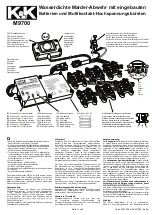
OV2PTOV is used to disconnect apparatuses, like electric motors, which will be damaged when
subject to service under high voltage conditions. It deals with high voltage conditions at
power system frequency, which can be caused by:
1.
Different kinds of faults, where a too high voltage appears in a certain power system, like
metallic connection to a higher voltage level (broken conductor falling down to a crossing
overhead line, transformer flash over fault from the high voltage winding to the low
voltage winding and so on).
2.
Malfunctioning of a voltage regulator or wrong settings under manual control
(symmetrical voltage decrease).
3.
Low load compared to the reactive power generation (symmetrical voltage decrease).
4. Earth-faults in high impedance earthed systems causes, beside the high voltage in the
neutral, high voltages in the two non-faulted phases, (unsymmetrical voltage increase).
OV2PTOV prevents sensitive equipment from running under conditions that could cause their
overheating or stress of insulation material, and, thus, shorten their life time expectancy. In
many cases, it is a useful function in circuits for local or remote automation processes in the
power system.
8.2.3
Setting guidelines
M13852-4 v10
The parameters for Two step overvoltage protection (OV2PTOV) are set via the local HMI or
PCM600.
All the voltage conditions in the system where OV2PTOV performs its functions should be
considered. The same also applies to the associated equipment, its voltage and time
characteristic.
There are wide applications where general overvoltage functions are used. All voltage related
settings are made as a percentage of a settable base primary voltage, which is normally set to
the nominal voltage level (phase-to-phase) of the power system or the high voltage equipment
under consideration.
The time delay for the OV2PTOV can sometimes be critical and related to the size of the
overvoltage - a power system or a high voltage component can withstand smaller overvoltages
for some time, but in case of large overvoltages the related equipment should be disconnected
more rapidly.
Some applications and related setting guidelines for the voltage level are given below:
The hysteresis is for overvoltage functions very important to prevent that a transient voltage
over set level is not “sealed-in” due to a high hysteresis. Typical values should be ≤ 0.5%.
8.2.3.1
Equipment protection, such as for motors, generators, reactors and
transformers
M13852-10 v3
High voltage will cause overexcitation of the core and deteriorate the winding insulation. The
setting has to be well above the highest occurring "normal" voltage and well below the highest
acceptable voltage for the equipment.
8.2.3.2
Equipment protection, capacitors
M13852-13 v1
High voltage will deteriorate the dielectricum and the insulation. The setting has to be well
above the highest occurring "normal" voltage and well below the highest acceptable voltage
for the capacitor.
Section 8
1MRK 505 370-UEN D
Voltage protection
210
Busbar protection REB670
Application manual
Summary of Contents for REB670 Series
Page 1: ...Relion 670 SERIES Busbar protection REB670 Version 2 2 IEC Application manual ...
Page 2: ......
Page 22: ...16 ...
Page 64: ...58 ...
Page 226: ...220 ...
Page 244: ...238 ...
Page 358: ...352 ...
Page 392: ...386 ...
Page 398: ...392 ...
Page 436: ...430 ...
Page 454: ...448 ...
Page 466: ...460 ...
Page 474: ...468 ...
Page 475: ...469 ...
















































